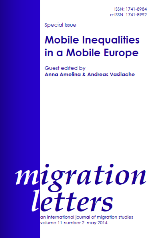Citizenship, Europe and ethnic boundary making among Russian minorities in Latvia and Lithuania
Citizenship, Europe and ethnic boundary making among Russian minorities in Latvia and Lithuania
Author(s): Claire Wallace, Natalka PatsiurkoSubject(s): Migration Studies
Published by: Transnational Press London
Keywords: Russian minorities; Baltic countries; identity; ethnic boundaries; civil society, nationalising states;
Summary/Abstract: This article uses Andreas Wimmer’s model of ethnic boundary making to examine ethnic boundaries among the Russian-speaking minorities in Lithuania and Latvia, two countries with contrasting integration policies. We argue that the exclusive integration policies of Latvia, particularly with regard to citizenship, result in the ‘hardening’ of ethnic boundaries for minorities, while the more inclusive policies in Lithuania lead to boundary ‘softening’. The article examines the influence of national policies, the policies of the Russian government and the European integration as external factors of boundary making, but also considers exogenous factors such as the role of the civil society, sense of identification, and the different experiences of generations. We conclude that whilst endogenous and exogenous factors have shaped ethnic boundaries in different ways in the two countries, these boundaries are blurring because Europe opens up wider possibilities for work and study and younger generations are less likely to be excluded from participation by language or citizenship. In both countries, increasingly hybrid and fluid identities are replacing reified and essentialist ones that are based upon the previous Soviet-style constructs.
Journal: Migration Letters
- Issue Year: 11/2014
- Issue No: 2
- Page Range: 187-205
- Page Count: 19
- Language: English

